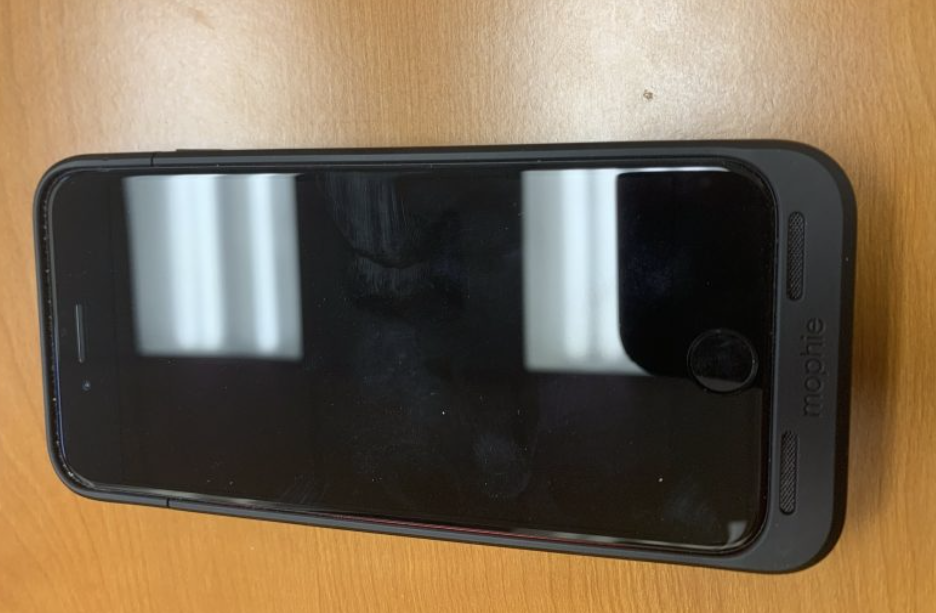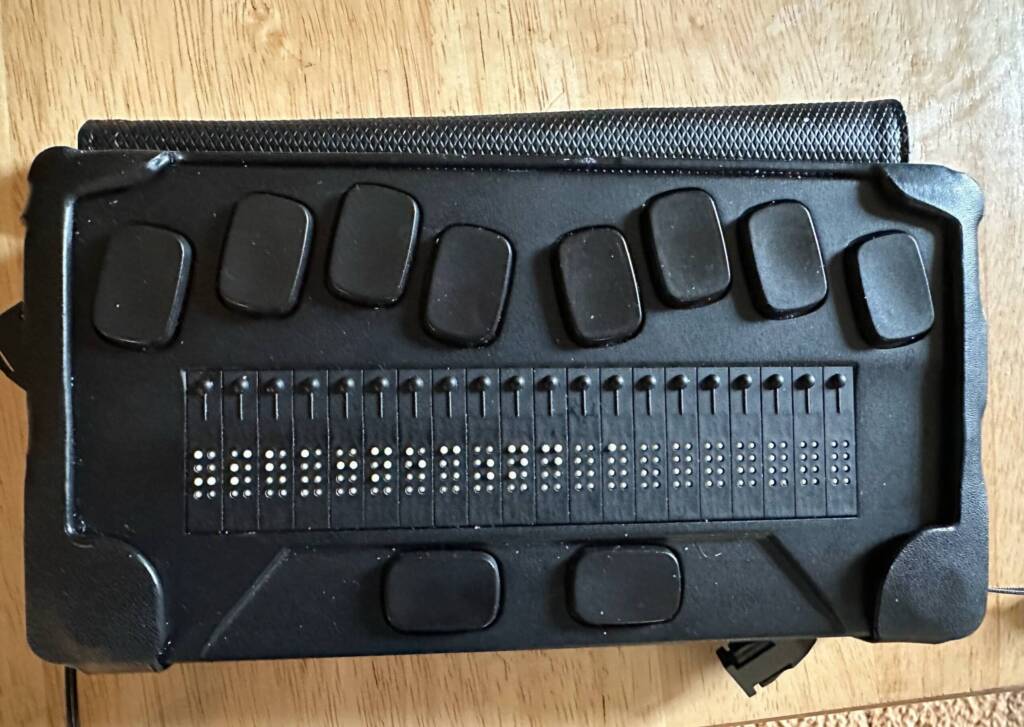When The Old Meets The New: A Review Of The iPhone SE 3
Read this review of the iPhone SE 3 including information about the setup, touch ID, recognition, hearing aid performance, audio and more.

By Scott Davert, Coordinator: Technology, Research and Innovation Center, Helen Keller National Center for DeafBlind Youths and Adults
April 4, 2022
Introduction
This review was completed after 10 days of using the iPhone SE 3. Most of my comparison will be with the iPhone SE 2 since that was the phone I had been using previously. For the sake of clarity, when referring to the previous generation of iPhone SE released in 2020, it will be referred to as the iPhone SE 2. Apple refers to the current model of iPhone SE simply by that name. This was also true of the first and second generation.
The iPhone SE3 is a step forward in some respects, but not in others. The reviews from the mainstream are generally positive, though many people feel the need to comment on the older design. This CNet review details how the new iPhone SE 3 compares to the SE 2 and other devices on the market. I will not spend much time discussing the mainstream features, as other blogs have already done this. I will, however, be discussing how the new iPhone SE 3 functions from the perspective of a blind and DeafBlind user.
It’s the same, only not
If you line up an iPhone SE 2, SE 3 and iPhone 8 side by side, it is impossible to tell them apart since the physical profile of each device is nearly identical. The 3 models are so similar that you can use the same cases for all 3 phones. I purchased a Mophie Juice Pack after being very confident in the rumors about the SE 3, and it fits perfectly on the new iPhone, just like it did on the SE 2.
As noted in the linked review, the iPhone SE 3 doesn’t have multiple rear cameras like you would find on the flagship iPhone 13 series. It also lacks the LiDAR sensor found on the iPhone 13 Pro. Another missing feature is the U1 chip which means that if you are an owner of Air Tags, you will not be able to take advantage of the precision finding features which provide useful information when locating an Air Tag.
The Setup
In my review of the iPhone SE 2, I noted that I was unable to transfer data from one device to another unless all other Bluetooth devices connected to my other phone were turned off. When setting up my SE 3, I left my braille display and hearing aids connected to the iPhone SE 2 and found that the transfer between them and the new iPhone worked flawlessly. This is a major improvement since I did not have to try using speech only through the internal speakers to make the transfer happen.
In 2018, the Universal Serial Bus Implementers Forum (USB-IF) approved a new Human Interface Device (HID) standard for braille displays. USB-IF is a non-profit organization comprised of many industry-leading companies such as Microsoft, Apple and Google. Their goal is to advance USB technology to make it more useable. What this means for consumers is that, if both the braille display manufacturer and mainstream technology manufacturer support it, you will be able to start a screen reader, plug a display in via USB and have access to braille with no further effort required. It will be unnecessary to find and install drivers, connect via Bluetooth or change settings before plugging your display into a USB port.
In 2020, Humanware announced that its forthcoming collaborative efforts into the braille display market with APH will also support the standard when it’s released. I decided to see if the HID standard would work 2 years after the announcement. Sadly, it did not work during the initial setup, but did work after the initial configuration. One limitation I found to the USB connection was unresponsiveness from the braille keyboard after the screen has been locked. This issue can be resolved by either restarting VoiceOver, or unplugging the display and then plugging it back in. It may also be worth noting that the braille display customized commands that have been set up under Bluetooth do not appear to work when connecting to USB. Though Apple indicated to me that they are not officially supporting the standard, I thought it would be a good idea to try it out.
Battery Life
The SE 3, according to Apple, will give the user 1 to 2 more hours of battery life than the SE 2. I would say that I get several hours more than I do with my SE 2. The SE 2 cannot give me enough power to last a full day without a battery case these days, but that could be because my location does not have reliable cell phone coverage. This was not an issue 2 years ago when I worked at a different location and was testing the iPhone SE 2, so I don’t feel confident in commenting on how the SE 2’s battery life was when new compared to the SE 3. Running 5G certainly offers a speed boost over 4G and doesn’t appear to run down the battery any more than when 5G is disabled. That said, I do not stream HD video content, which is where the user would most likely encounter the further battery drain. Streaming audio did not seem to impact battery life as I consistently had between 15-20% battery left at the end of the day.
Buying some bugs
This particular section is mostly for users of braille displays. If you have been holding off on upgrading iOS due to some issues related to braille devices, the iPhone SE 3, or any other new iOS Device, will be running 15.4 or 15.4.1. The good news about iOS 15.4.1 is that one frustration which has been eliminatet. The bug in 15.4 was that quite often, when panning through text using a braille display, the panning command or buttons will not respond, or will respond twice skipping past content that should be displayed.
Some issues remain in iOS 15.4.1. If you enjoy writing emails in the native Mail app, you probably will not on iOS 15.4.1 if you wish to be able to insert line breaks. This is because when editing or composing an email in the Mail app using a braille display, after inserting a line break, focus will appear to jump to the top of the screen, even though the cursor has not. If that’s not enough, the aforementioned bug also appears to trigger another one: when composing a lengthy email with the Apple Mail app using a braille display random words will be inserted in the incorrect place, especially after a line break is inserted. The first bug has been around since iOS 15.1, so there is no guarantee a fix will be coming any time soon. Interestingly, there were also issues with braille and editing text noted in my SE 2 review so, in some ways, this seems as though things may not change anytime soon. Those considering the purchase of any new iOS Device may wish to bear this information in mind.
The Home Button and Touch ID
The SE 3 maintains Touch ID and the Home button. The Home button seems to be preferred by a large number of the consumers I work with. In fact, customizing a gesture for going to the Home screen on iOS Devices without Home buttons is probably the most common thing I support consumers with when we begin training. As such, many have requested the SE 2 and now may begin requesting the SE 3 for this reason.
Though Apple has said that users can now unlock their iOS devices with a face mask in iOS 15.4, several users have reported struggles using this new feature. With Touch ID, there isn’t an issue. For my use case, the Home button isn’t really a consideration itself. Touch ID is the biggest reason I decided to upgrade to this particular model. As a braille-only user, there is no point to me taking my phone out of my pocket since my braille display is connected through Bluetooth. Touch ID is very fast, since I can just rest a thumb on the Home button to unlock my iPhone. When comparing Touch ID between the SE 2 and SE 3, there was no noticeable difference in terms of the speed at which the device was unlocked.
Recognition
One of the concerns with the SE 3 when compared to the other flagship iOS devices is that the lack of a series of cameras will negatively impact the results of OCR. In my testing, where I compared the iPhone 13 Mini with the SE 2 and SE 3, there is little discernible difference between the 3. I used Voice Dream Scanner to obtain these results and performed all testing on the same stand in the same environment with the same lighting. One of the exceptions in my results was in situations where there was less light. The iPhone SE 2 and SE 3 appeared to have the same number of errors, whereas the 13 I was testing had none. The one area where the SE 3 outperforms the SE 2 is the speed at which it gets an OCR result. The SE 3, not surprisingly, produced faster results. This is likely a difference between the A13 chip on the SE 2 and the A15 processor found in the SE 3.
Currency recognition, when using the Cash Reader app seemed equally fast and accurate on all 3 devices. The SE 2, SE 3, and 13 all were able to recognize bills in under 2 seconds. These bills were tested under the same environmental conditions mentioned above.
Hearing aid performance
I reported in my SE 2 review that it seemed as though the difference in processors between the iPhone 8 and SE 2 allowed the user to have a more stable Bluetooth connection. I was a little disappointed to find no further improvements between the SE 2 and SE 3, other than that, the lag with Live Listen seems to have decreased. I would estimate about a half second delay between when the person speaks and when their speech comes through the iPhone using the SE 2. The SE 3 seems to have a delay of about a quarter of a second.
Whether using mFI hearing aids or those which simply connect through Bluetooth, the only improvement I noticed was that the Bluetooth connection did not become less stable when I was using, for example, my braille display to interact with the phone and my hearing aids to listen to audio. Though the Bluetooth connection still becomes choppy from time to time on the SE 3, I have noticed it happens a bit less than on the SE 2. I noticed, for example, that I had issues with Bluetooth 3 times in an hour when using the SE 2. That went down to 1 time the next hour when using the SE 3.
Audio
Though my ears are certainly not the best judge, I am still able to hear sound quality differences when they are dramatic enough. Unless I’m comparing the SE 2 with the SE 3. I had a friend hang on to both the SE 2 and SE 3 and randomly play the same song through one device or another. My guesses were only correct about 40% of the time. When reversing the exercise, my friend, who says he has normal hearing, could also not tell the difference reliably. If there is an improvement, then it is my conclusion that the differences are very subtle.
When testing for any sort of lagginess with the SE 2 and SE 3, I noted none when using speech output. Concerning Siri, I noticed that the SE 3 is much faster than the SE 2, likely because of the 5G connection. Speaking of 5G, the SE 3 does not have access to the MM wave band of frequencies. What this means is that the iPhone 13 will likely outperform the SE 3 when in cities where 5g has been deployed and works correctly. Locally, there appeared to be no difference between the 13 and SE 3.
Conclusion
Just like with the flagship products versus the older models going back to the original iPhone SE, there are compromises with the SE 3. One of those compromises is the price tag. At $429 for the 64 GB version, it’s the cheapest iPhone on the market. Though there are some things missing from the SE 3 which are on the flagship iPhones, like the camera system, Face ID and a longer battery life, for some individuals it will be a more solid solution. As for me, I was considering returning the SE 3 due to the annoying braille panning issues I did not have to contend with on my SE 2, which is still running iOS 15.1. After some bugs were resolved in 15.4.1, I will keep the phone since the increased speed and longer battery life when compared to the SE 2 are welcomed changes.


